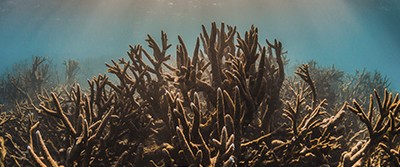Fish Lured Back to Abandoned Coral Reefs by Sound

By Sadie Laurie
Dying coral reefs around the world have fallen silent. There are no more sounds of bustling fish among the limestone labyrinths because they have left to search for other, healthier environments. Warming ocean temperatures are to blame for setting off a chain of events that are driving reef inhabitants away. But marine biologists may have found a way to lure them back — with sound.
A recent study, conducted by an international research team from the United Kingdom’s Universities of Exeter and Bristol in England and Australia's James Cook University and Australian Institute of Marine Science, investigated the effect sound would have on marine animals in the Australian Great Barrier Reef. Led by Tim Gordon, the group published their findings in the paper “Acoustic enrichment can enhance fish community development on degraded coral reef habitat” that appeared in Nature Communications.
"Healthy coral reefs are remarkably noisy places — the crackle of snapping shrimp and the whoops and grunts of fish combine to form a dazzling biological soundscape,” said senior author Professor Steve Simpson of the University of Exeter in a university press release. “Juvenile fish home in on these sounds when they're looking for a place to settle."
Calling Out to the Community
Gordon’s group wondered if they could use recordings of the healthy sounds to draw fish back to abandoned reefs to kick-start the natural recovery process. They placed underwater loudspeakers among patches of dead coral that broadcasted a cacophony of crackles, whoops, and grunts.
"Reefs become ghostly quiet when they are degraded, as the shrimps and fish disappear,” said Simpson. “But by using loudspeakers to restore this lost soundscape, we can attract young fish back again."
Colorful Coral Colonies
Thriving reef ecosystems are home to thousands of tiny soft-bodied organisms, called coral polyps, that are related to sea anemones and jellyfish. At their base, they have a hard, protective skeleton called a calicle. Made of limestone, the calicle forms the coral reef structure when it attaches to a rock on the sea bottom and divides into thousands of clones. The connected calicles result in a colony that exists as a single organism that joins with other colonies over time to form reefs.
The reefs get their color from brightly hued tiny algae that live inside the polyps’ tissue. Called zooxanthellae (ZOH-oh-ZAN-thell-ee), they have a symbiotic relationship with the polyps. They get a place to live in exchange for the food they provide to the polyps through photosynthesis.
But when water temperature rises even slightly — like it did on the Great Barrier Reef in 2016 before a massive bleaching event — zooxanthellae become damaged and their polyp hosts kick them out. This causes the loss of color in the reefs or “bleaching.” Then the polyps have less to eat and eventually die, and the noisy creatures who live in the area move elsewhere, causing the whole ecosystem to fall apart.
Creating a Space for Regrowth
Gordon’s team knows that bringing marine life back to dead reefs won’t automatically reverse the dire situation, but industrious fish could begin the recovery process by cleaning reefs and creating space for new coral growth.
The group’s study showed that a speaker system could be successful at motivating the fish into action. When it broadcasted healthy reef sounds, it doubled the total number of fish arriving onto experimental patches of reef habitat and increased the number of species present by 50 percent, according to University of Exeter reports. Diversity in the fish population is important for maintaining a healthy ecosystem because all of the groups have different roles to play.
Rehabilitating Reefs
Andy Radford, University of Bristol professor and co-author on the study, is optimistic about their acoustic enrichment technique.
"If combined with habitat restoration and other conservation measures, rebuilding fish communities in this manner might accelerate ecosystem recovery,” he said as stated in the press release. "However, we still need to tackle a host of other threats including climate change, overfishing and water pollution in order to protect these fragile ecosystems."
Gordon looks forward to exploring the technique further as a tool to preserve the precious and vulnerable reef ecosystems, according to University of Exeter reports.
"From local management innovations to international political action, we need meaningful progress at all levels to paint a better future for reefs worldwide."
By restoring coral reefs, we not only provide the opportunity for future generations to benefit from the food, medicine, protection from storms, and fishing and tourism revenue they provide, we also enable future generations to delight in their beauty.
Discussion Questions
- Why are coral reefs important to humans?
- What kinds of fish live among coral reefs?
- What may happen to those fish if they aren’t able to find coral reefs where they can live?
Vocabulary
- Acoustic
- Algae
- Coral
- Symbiotic
- Photosynthesis